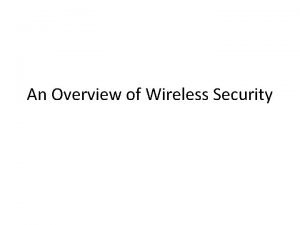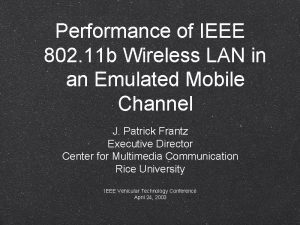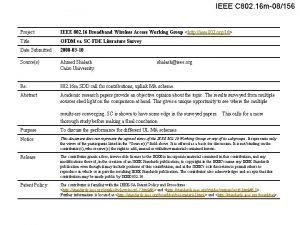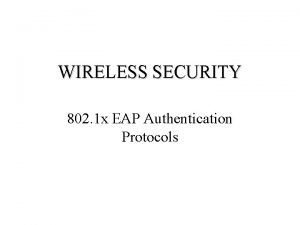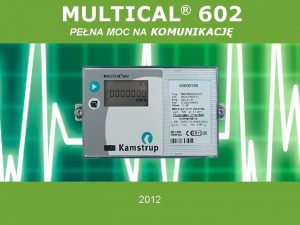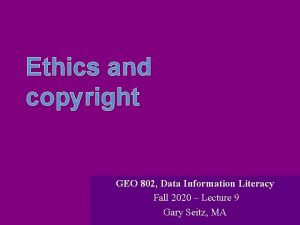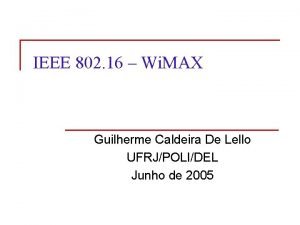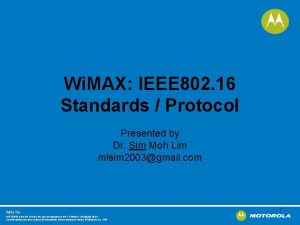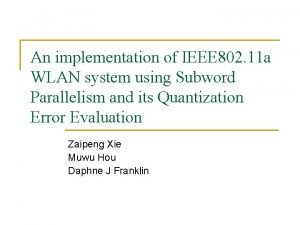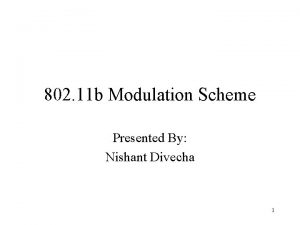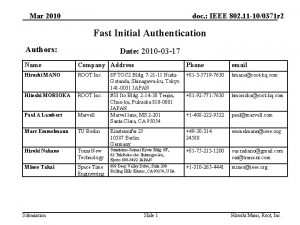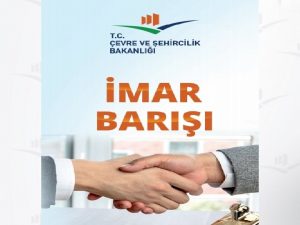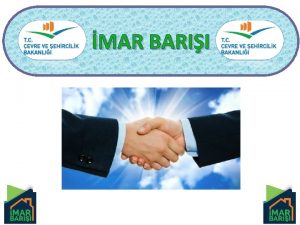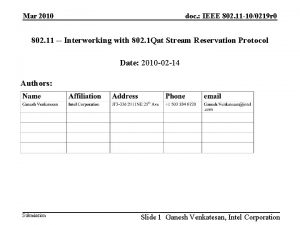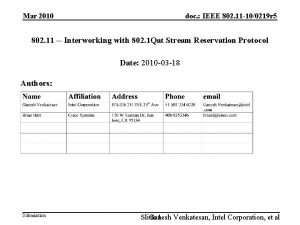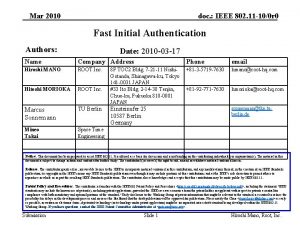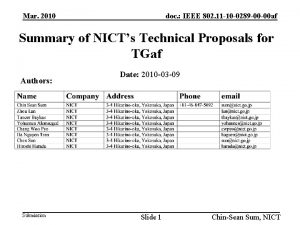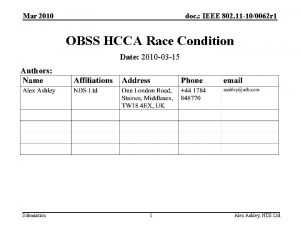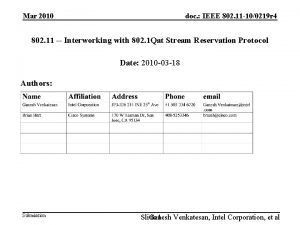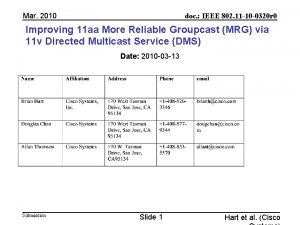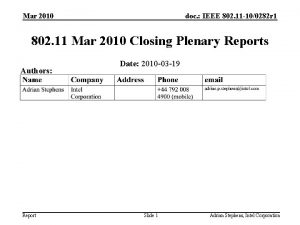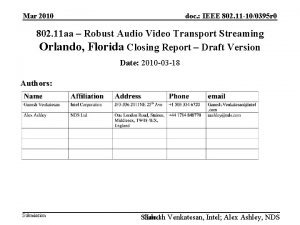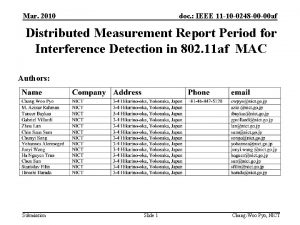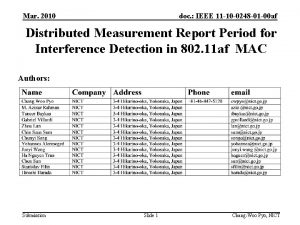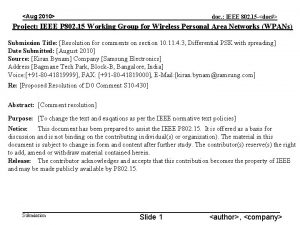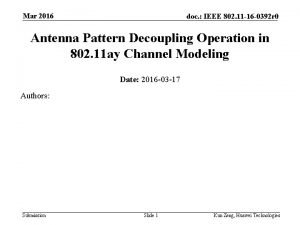Mar 2010 doc IEEE 802 11 100371 r

















![Mar 2010 doc. : IEEE 802. 11 -10/0371 r 0 References [1] H. Morioka, Mar 2010 doc. : IEEE 802. 11 -10/0371 r 0 References [1] H. Morioka,](https://slidetodoc.com/presentation_image/e44685d1784b41ee6dcf350e4b607655/image-18.jpg)
![Mar 2010 doc. : IEEE 802. 11 -10/0371 r 0 References [11] M. Emmelmann. Mar 2010 doc. : IEEE 802. 11 -10/0371 r 0 References [11] M. Emmelmann.](https://slidetodoc.com/presentation_image/e44685d1784b41ee6dcf350e4b607655/image-19.jpg)


- Slides: 21

Mar 2010 doc. : IEEE 802. 11 -10/0371 r 0 Fast Initial Authentication Authors: Date: 2010 -03 -17 Name Company Address Phone email Hiroshi MANO ROOT Inc. +81 -3 -5719 -7630 hmano@root-hq. com Hitoshi MORIOKA ROOT Inc. +81 -92 -771 -7630 hmorioka@root-hq. com Paul A Lambert Marvell 8 F TOC 2 Bldg. 7 -21 -11 Nishi. Gotanda, Shinagawa-ku, Tokyo 141 -0031 JAPAN #33 Ito Bldg. 2 -14 -38 Tenjin, Chuo-ku, Fukuoka 810 -0001 JAPAN Marvel lane, MS 2 -201 Santa Clara, CA 95054 +1 -408 -222 -9522 paul@marvell. com Marc Emmelmann TU Berlin Einsteinufer 25 10587 Berlin Germany +49 -30 -314 24580 emmelmann@ieee. org Hiroki Nakano Trans New Technology Sumitomo-Seimei Kyoto Bldg. 8 F, 62 Tukiboko-cho Shimogyo-ku, Kyoto 600 -8492 JAPAN +81 -75 -213 -1200 cas. nakano@gmail. com cas@trans-nt. com Mineo Takai Space Time Engineering 609 Deep Valley Drive, Suite 200 Rolling Hills Estates, CA 90274, USA +1 -310 -265 -4441 mineo@ieee. org Submission Slide 1 Hiroshi Mano, Root, Inc.

Mar 2010 doc. : IEEE 802. 11 -10/0371 r 0 Agenda • Motivation and background of proposal • Limitation of coexisted standard – Long time initial authentication – Scalability of simultaneous access for initial authentication – Operator oriented roaming support • Example idea of Fast secure Initial Authentication – Implementation of fast secure initial authentication • Time Analysis • Security Analysis – Example idea of supporting contentious IP connection • Straw Poll/Motion Submission Slide 2 Hiroshi Mano, Root, Inc.

Mar 2010 doc. : IEEE 802. 11 -10/0371 r 0 Limitation of market growth in the existing 802. 11 • IEEE 802. 11 evolved greatly for the past ten years and got big success in a market – Bandwidth : • 11/2 Mbps → 11 b/11 Mbps→ 11 g/54 Mbps → 11 n/300 Mbps – Securities : • WEP->WPA 2 – Service device • Desktop PC → Note Book → PDA → Portable game, Digital Camera → Hybrid cell phone. • However – We are still in nomadic services. Submission Slide 3 Hiroshi Mano, Root, Inc.

Mar 2010 doc. : IEEE 802. 11 -10/0371 r 0 Nomadic Vs Mobile • Nomadic • STA must be stationary while in use. • Mobile • STA do not need stop while in use. Reference : RECOMMENDATION ITU-R F. 1399 -1 “Vocabulary of terms for wireless access” MWA & NWA Submission Slide 4 Hiroshi Mano, Root, Inc.

Mar 2010 doc. : IEEE 802. 11 -10/0371 r 0 Today’s market back ground – Growth of portable device • Number of portable device which incorporate Wi-Fi is more than PC’s • Low power consumption device realized the use of the always-on connection type service. – New application’s request (Twitter, Face book…) • Push Notification Service • Quick update – Only cell phone provide these service – Highly bandwidth • Very SMALL CELL of each AP Submission Slide 5 Hiroshi Mano, Root, Inc.

Mar 2010 doc. : IEEE 802. 11 -10/0371 r 0 Prospect of use case 1 • Quick update contents and push service. – You can update new messages and location data while just passing an AP's coverage. – So you do not have to stop many times like serious landing operation. – Service provider can distribute the handbill without stopping the foot of the customer. • Location • Pop E-mail • Twitter Handbill Messages Location New location and presence Updated new twitters and messages Get new handbills No need stop! Just pass through! Submission Slide 6 Hiroshi. Mano, Root, Inc.

Mar 2010 doc. : IEEE 802. 11 -10/0371 r 0 Prospect use case 2 • Automatic Electrical Cash Register • Security Gate ID Exchange No need stop! Just pass through! Submission Slide 7 Hiroshi. Mano, Root, Inc.

Mar 2010 doc. : IEEE 802. 11 -10/0371 r 0 Prospect use case 3 • Automatic metering – Power electric – Water meter – etc. . Submission Slide 8 Hiroshi Mano, Root, Inc.

Mar 2010 doc. : IEEE 802. 11 -10/0371 r 0 Limitation of coexisted standard • Long Authentication and Key Management time loosing scalability • Limited number of simultaneous access of initial authentications • Limited speed of moving devices Submission Slide 9 Hiroshi Mano, Root, Inc.

Mar 2010 doc. : IEEE 802. 11 -10/0371 r 0 Scope of. 11 r and. 11 i Operator I Network A ESSID 1 AP AP Operator II ESSID 2 AP Intra-Network Fast Handover is supported by. 11 r AP AP ESSID AP AP . 11 i is used for Initial authentication • IEEE 802. 11 r support high speed mobility within the same ESSID Submission Slide 10 Hiroshi Mano, Root, Inc.

Mar 2010 doc. : IEEE 802. 11 -10/0371 r 0 Time consumption for initial authentication Waste much time to … 1. Discover a new AP. • 2. Make association with a new AP. (includes authentication/key exchange…) • 3. 4. Latency can be reduced by 11 k or background scan. 11 i authentication is not so fast. – It needs many packet exchanges. Upper layer setup. (Out of Scope) Upper layer handover. (Out of Scope) Most of time consumption in initial authentication process is used for AKM. Therefore Fast Secure initial authentication is key solution for high speed mobility. Submission Slide 11 Hiroshi Mano, Root, Inc.

Mar 2010 doc. : IEEE 802. 11 -10/0371 r 0 Handover Taxonomy Handover Phases Network Discovery Handover Decision Link layer (re-) establishment = Scanning and other means • Goal: Find other BSSs in reach • Active / passive scanning not mandatory for network discovery but only for synchronizing TSF timer • Implicit knowledge (neighborhood reports) in combination with localization • Existing approaches e. g. background scanning can reduce the delay to tens of ms [1 --4] Associated delay theoretically noticeable if we can avoid requiring synchronization of TSF timer during the handover process = when to leave old BSS and connect to new one • Decision based on (vendor specific) algorithm not the concern of the standard • Several approaches potentially resulting in zero delay handover possible • Location based in combination with estimation of AP’s coverage area • RSS-based [1, 5 --7] = Authentication, Association (+ security) • No Security: Open Authentication & Association @ 1 Mbps = 2. 8 ms mean value + time for required synchronization of TSF (2 ms mean) Total of 4. 8 ms [1] • Adding Security: IEEE 802. 11 i ( PEAP/EAP-MSCHAPv 2) increases delay to at least 48 ms, large number of simultaneous handover cause a tremendous network load due to the large number of message exchanges does not scale • Optimized: IEEE 802. 11 r can reduce delay to up to XXXXX but can be only applied within a single ESS Currently, we do not have a fast handover including security that a) is suitable for frequent handover scenarios due to highly mobile users b) scales for large number of simultaneously occurring handovers Submission

Mar 2010 doc. : IEEE 802. 11 -10/0371 r 0 Protocol Sequence between AP and STA on IEEE 802. 11 i ( PEAP/EAP-MSCHAPv 2) STA AP Probe (1 round trip) Authentication (1 round trip) Association (1 round trip) EAPOL-Start EAP-Identity (1 round trip) Establishing TLS tunnel for PEAP (3 round trip) PEAP EAP-MSCHAPv 2 (4 round trip) EAP-Success EAPOL-Key (2 round trip) Submission Slide 13 13 Total: 14 round trip Hiroshi Mano, Root, Inc.

Mar 2010 doc. : IEEE 802. 11 -10/0371 r 0 Airtime consumption for every single authentication process • • • We observed an STA connecting to an AP with PEAP/MS-CHAPv 2 by IEEE 802. 11 g. All management frames were transmitted in 1 Mbps mode. Required airtime for one unicast frame is defined as described below. Occupied Time Frame DIFS • • • a. Slot. Time: a. SIFSTime: a. Preamble. Length: a. PLCPHeader. Length: a. CWmin: a. CWmax: CW 20 us 144 us 48 bits 31 1023 ACK TXTIME SIFS TXTIME • DIFS: • CW: 50 us 620 us • ACKRate: • ACKLength: 1 Mbps 14 Bytes PEAP/EAP-MSCHAPv 2 needs 14 round trip frame exchanges. From our observation result, total frame length without PLCP header is 4390 byte. An STA needs 48. 4 ms airtime connecting to an AP. Submission Slide 14 Hiroshi Mano, Root, Inc.

Mar 2010 doc. : IEEE 802. 11 -10/0371 r 0 Simulation 1 • Assumption – – – – • • • Place: Train Station Time: Rush Hour Walking Speed: 4. 8 km/h=80 m/min AP cover area: 80 m*80 m square Occupied Space by 1 Person: 2 m*2 m square All persons have a cellular phone which supports WLAN. All persons are walking same direction. 1, 600 STAs are passing through the AP’s cover area in 1 minutes. this means 1, 600 authentication process should be proceeded during every 1 minutes. Every authentication process needs 48. 4 ms airtime to connect to the AP. Only 1, 238 authentication process can be proceeded. There is no time space to data communication. Furthermore, AP transmits beacons, STA needs DHCP… exiting initial authentication is not scale for mobility Submission Slide 15 Hiroshi Mano, Root, Inc.

Mar 2010 doc. : IEEE 802. 11 -10/0371 r 0 Simulation 2 • • • 0 -100 STAs are already connected to an AP and up/downloading data. (Static STA) 1 -100 STAs are simultaneously coming into the cell and make authentication. (Moving STA) Assumption – All STAs uses OFDM – DATA frames are transmitted in 54 Mbps – Management frames are transmitted in 6 Mbps • Analyzed required time to complete authentication for all moving STAs. Moving STAs Submission Static STAs

Mar 2010 doc. : IEEE 802. 11 -10/0371 r 0 Simulation 2 Result Submission
![Mar 2010 doc IEEE 802 11 100371 r 0 References 1 H Morioka Mar 2010 doc. : IEEE 802. 11 -10/0371 r 0 References [1] H. Morioka,](https://slidetodoc.com/presentation_image/e44685d1784b41ee6dcf350e4b607655/image-18.jpg)
Mar 2010 doc. : IEEE 802. 11 -10/0371 r 0 References [1] H. Morioka, H. Mano, M. Ohmori, M. Ohta, "MIS Protocol for Secure Connection and Fast Handover on Wireless LAN", No. 454, The IEEE 20 th International Conference on Advanced Information Networking and Applications, Austria, Apr. 18 -20, 2006 [2] H. Morioka, H. Mano, M. Ohmori, M. Ohta, M. Hirabaru, M. Hasegawa, M. Inoue, "Seamless Handover with Wireless LAN, Mobile IP, MISP and PDMA", The 9 th International Symposium on Wireless Personal Multimedia Communications, 2006 [3] H. Morioka, H. Mano, "Broadband V 2 I Access for High Speed Transportation", 09/0111 r 3 [4] H. Mano, H. Morioka, "IEEE 802. 11 for High Speed Mobility", 09/1000 r 6 [5] H. Nakano, H. Morioka, H. Mano, "An Exsample Protocol for Fast. AKM", 10/0059 r 3 [6] H. Nakano, H. Morioka, H. Mano, "Fast Initial Authentication", 10/0361 r 0 [7] M. Emmelmann. System Design and Proof-of-Concept Implementation of Seamless Handover Support for Communication-Based Train Control. In M. Emmelmann, B. Bochow, and C. Kellum, editors, Vehicular Networking -- Automotive Applications and Beyond. John Wiley & Sons, 2010, ISBN: 9780470741542. [8] M. Emmelmann, S. Wiethölter, and H. -T. Lim. Continuous network discovery using Opportunistic Scanning. 802. 11 WNG SC Wireless Next Generation Standing Committee. Doc. 09/1207 r 1. IEEE 802. 11 Plenary, Atlanta, GA, USA, November 16 -- 20, 2009. [9] M. Emmelmann and H. -T. Lim. Empirical Evaluation of Overlap Requirements of Adjacent Radio Cells for Zero Delay Handover. In Proc. of Vehicular Technology Conference (VTC) Fall 2009, Anchorage, Alaska, USA, Sep 20 -23, 2009. [10] M. Emmelmann, S. Wiethölter, and H. -T. Lim. Opportunistic Scanning: Interruption-Free Network Topology Discovery for Wireless Mesh Networks. In Porc. of International Symposium on a World of Wireless, Mobile and Multimedia Networks (IEEE Wo. WMo. M), Kos, Greece, June 15 -19, 2009. Submission
![Mar 2010 doc IEEE 802 11 100371 r 0 References 11 M Emmelmann Mar 2010 doc. : IEEE 802. 11 -10/0371 r 0 References [11] M. Emmelmann.](https://slidetodoc.com/presentation_image/e44685d1784b41ee6dcf350e4b607655/image-19.jpg)
Mar 2010 doc. : IEEE 802. 11 -10/0371 r 0 References [11] M. Emmelmann. Velocity Effects on RSM-based Handover Decision. 802. 11 TGt Wireless Performance Prediction Task Group Doc. 05/0233 r 1. IEEE 802. 11 Plenary, Atlanta, USA, March 13 -- 18, 2005. [12] Marc Emmelmann. "Influence of Velocity on the Handover Delay associated with a Radio-Signal-Measurement -based Handover Decision". In Proc. of IEEE Vehicular Technology Conference (VTC 2005 Fall), Dallas, TX, USA, September 2005. Digital Object Identifier 10. 1109/VETECF. 2005. 1558955. [13] M. Emmelmann and H. -T. Lim. Empirical Evaluation of Overlap Requirements of Adjacent Radio Cells for Zero Delay Handover. In Proc. of Vehicular Technology Conference (VTC) Fall 2009, Anchorage, Alaska, USA, Sep 20 -23, 2009. Submission

Mar 2010 doc. : IEEE 802. 11 -10/0371 r 0 Questions & Comments Submission Slide 20 Hiroshi Mano, Root, Inc.

Mar 2010 doc. : IEEE 802. 11 -10/0371 r 0 Straw Poll? Motion? “? ” Submission Slide 21 Hiroshi Mano, Root, Inc.











